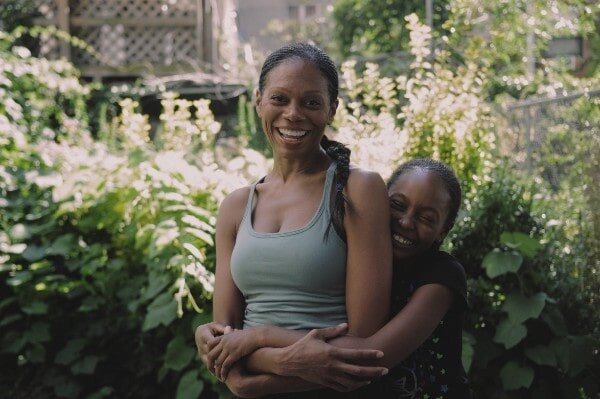Everyone’s a little on edge these days, and kids are no exception. During a Zoom call on mindful parenting during the pandemic, child therapist and mom of three Brandy Wells talked to the mater mea community about how sensory play can help with processing kids’ big feelings.
We asked Brandy to talk to us a little more about what sensory play is and how parents can use it at home.
When parents are stressed out, children feel and carry the weight of that. Kids are very instinctual; they’re very good at figuring out what’s going on, and they begin to manifest that. When your kid is experiencing a meltdown or having a tantrum, their brain is in fight or flight mode. It’s what everyone experiences when their body is feeling alarmed.
Since sensory play decreases stress, kids are able to relax and make rational decisions.
Whenever your kids are experiencing big feelings, the best thing you can do is , get them to a calm state, and present them with some coping strategies. I like to use sensory play and heavy work to help my own children stay calm.
What is sensory play?
Sensory play and heavy work are exactly what they sound like: using your senses and physical body to self-soothe.
If you think about it, sensory play and heavy work are already a part of our everyday lives. We are always smelling, feeling, tasting, lifting, and moving.
Sensory play and heavy work are just an expansion of what your child is already doing.
What are the benefits of sensory play?
Sensory play has many benefits. It helps:
- keep kids’ brains in a calm state,
- regulate their body temperatures,
- release “feel good” hormones throughout their bodies,
- stimulate the brain stimulation, and
- promote healthy development.
Since sensory play decreases stress, kids are able to relax and make rational decisions (e.g. listen to you). Think about it as a way to prevent tantrums, and to create a calming vibe before transitioning into a challenging activity like bedtime.

What are the different types of sensory play?
Take a look at my top sensory and heavy work ideas that are practical, easy, and fun!
Touch-Based Sensory Play
Touch can have a very calming effect on kids. It provides physical connection with parents. The touching doesn’t have to be somewhere specific—just apply deep pressure to areas that have more tension.
- Massages
- Bear hugs
- Body socks: These are sensory tools that your older kids can use to help calm the body. A body sock is something that you climb into like a cocoon. A kid can put their entire body in it, and some kids really like that sense of pressure and enclosure and feeling hidden. (For adult-sized body socks, check out these options: 1, 2, 3)

Exercise-Based Sensory Play
When you think about regulation, it’s just about releasing endorphins in your body, and exercise and movement can do that. There are YouTube channels like Get Kids Moving, or you can use any of these exercises.
- Yoga poses: Yoga is about mindfulness, tuning in to parts of your body, and releasing tension. It’s an exercise that is really calming—it’s not going to get your kid more hype. I like Cosmic Kids Yoga, which offers specific yoga tools for kids.
- Resistance bands: Resistance bands come in different weights. Pulling resistance bands can help with regulation. Your kids can use them on their legs or on their arms. (Editor’s note: You can purchase these Black-owned high-quality resistance bands and use them for your own workouts when your kids aren’t using them.)
- Wall push-ups
- Wall sits
- Chair dips
- Animal walks: That’s like walking like a crab, hopping like a bunny or frog, or crawling like a bear.
- Passing games with weighted stuffed animals
- Boxing with boxing gloves against a mat
- Tug of war with Pop Toobs
- Stepping up onto a chair or bench and jump down (with close supervision!)
Using exercise as a form of sensory play depends on the developmental age of your child. I’m not going to make my 5 year old do 20 or 30 reps. Also, don’t wait until a kid is experiencing a meltdown to say, “Ok, go ahead and do some wall push ups!” You’re not in your rational brain when you’re having a meltdown. Make sure your kids do these exercises when they’re still feeling ok.

Heavy Work and Sensory Play
Heavy work helps decrease the heart rate, which helps relax the body. Sensory play is a calming strategy—it helps kids focus in on a task and get their brain off of whatever it was that was increasing their heart rate. Some examples of heavy work and sensory play include:
- Tossing and catch heavy bean bags
- Rolling a therapy ball up and down the wall
- Playing with weighted sensory bottles: I make my own DIY sensory bottles. They’re basically part water, part glue, and then you add beads or glitter. They’re like snow globes—if a kid is really frustrated or experiencing a meltdown, they can really tune into the glitter and get back to a peaceful state.
- Squeezing putty or Play-Doh
- Tearing paper (especially heavier cardstock)
- Crumpling up paper and shooting it into a garbage can
- Pushing and pulling Squigz
- Doing some cooking activities (e.g. kneading, stirring thick dough)
- Squeezing sensory balloons (filled with dry beans, dry rice, or Play-Doh)
- Digging in a tactile bin of wet or Kinetic Sand
- Writing on a dry erase board and then erasing it
How to Use Sensory Play in Parenting
With all the uncertainty and stressors in the world, it’s important for us to validate how our kids are feeling. We have to move past just saying, “I know you’re sad right now” and be able to tell them, “Here are some things you can do to get your mind off of it and try to get your body to feel good.”
Sensory play isn’t going to change the world, but at least now they’ll have some tools to help them. Now, instead of throwing a tantrum, they’ll think, “I’m really feeling frustrated. You know what? I’m going to do 10 wall push-ups. I’m about to go take a walk. I’m ’bout to go get my body sock to provide a sense of security.”
It’s important to have tools in your tool kit no matter how old you are. By introducing your kids to sensory play at home, you’re giving your kids the tools they’ll need for their own wellness and mindfulness journeys during and after COVID-19.
This article includes affiliate links. mater mea may receive a commission if you purchase an item through one of these links.















